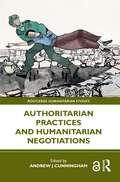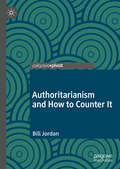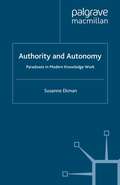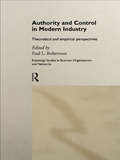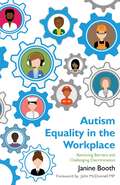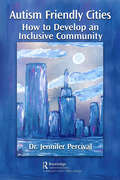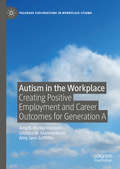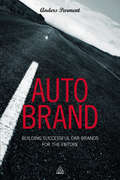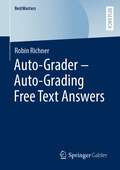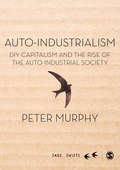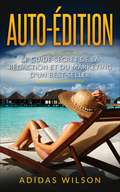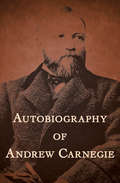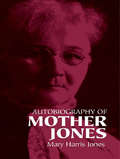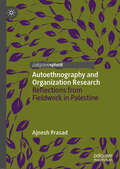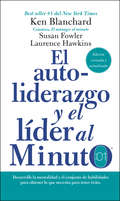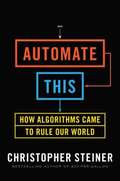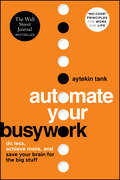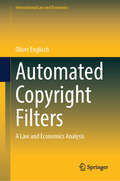- Table View
- List View
Authoritarian Practices and Humanitarian Negotiations (Routledge Humanitarian Studies)
by Andrew J CunninghamThis book examines authoritarian practices in relation to humanitarian negotiations. Utilising a wide variety of perspectives and examining a range of contexts, the book considers how humanitarians assess and engage with authoritarian practices and negotiate access to populations in danger. Chapters provide insights at the macro, meso, and micro levels through case studies on the international and domestic legal and political framing of humanitarian contexts (Xinjiang, Afghanistan, Venezuela, Russia, and Syria), as well as the actual practice of negotiating with authoritarian regimes (Ethiopia). A theoretical grounding is provided through chapters elaborating on the ethics and trust-building dimensions of humanitarian negotiations, and an overview chapter provides a theoretical framework through which to analyse humanitarian negotiations against the backdrop of different types of authoritarian practices. This book provides a wide-ranging view which broadens the frame of reference when considering how humanitarians view and engage with authoritarian practices. The objective is to both put these contexts into conceptual order and provide a firm theoretical basis for understanding the politics of humanitarian negotiations in such difficult contexts. This book is useful for those studying international politics and humanitarian studies, as well as for practitioners seeking to better systematise their humanitarian negotiations.
Authoritarian Practices and Humanitarian Negotiations (Routledge Humanitarian Studies)
by Andrew J CunninghamThis book examines authoritarian practices in relation to humanitarian negotiations. Utilising a wide variety of perspectives and examining a range of contexts, the book considers how humanitarians assess and engage with authoritarian practices and negotiate access to populations in danger.Chapters provide insights at the macro, meso, and micro levels through case studies on the international and domestic legal and political framing of humanitarian contexts (Xinjiang, Afghanistan, Venezuela, Russia, and Syria), as well as the actual practice of negotiating with authoritarian regimes (Ethiopia). A theoretical grounding is provided through chapters elaborating on the ethics and trust-building dimensions of humanitarian negotiations, and an overview chapter provides a theoretical framework through which to analyse humanitarian negotiations against the backdrop of different types of authoritarian practices.This book provides a wide-ranging view which broadens the frame of reference when considering how humanitarians view and engage with authoritarian practices. The objective is to both put these contexts into conceptual order and provide a firm theoretical basis for understanding the politics of humanitarian negotiations in such difficult contexts. This book is useful for those studying international politics and humanitarian studies, as well as for practitioners seeking to better systematise their humanitarian negotiations.
Authoritarianism and How to Counter It
by Bill JordanAfter the collapse of the Soviet Union, it was assumed that liberal democracies would flourish worldwide. Instead, today authoritarian leaders are gaining power – from Trump’s US and Bolsonaro's Brazil to Orban's Hungary – while Russia and China have turned back towards their old, autocratic traditions. This book examines the origins and implications of this shift, and focusses especially on the longstanding coercion of poor people. As industrial employment, and now also many service jobs, are being replaced through technological innovations, state-subsidised, low-paid, insecure work is being enforced through regimes of benefits cuts and sanctions. Authoritarians are exploiting the divisions in the working class that this creates to stoke resentment against immigrants and poor people. The author identifies new social movements and policies (notably the Universal Basic Income) which could counter these dangers.
Authority and Autonomy: Paradoxes in Modern Knowledge Work
by Susanne EkmanOffers a detailed and entertaining analysis of the daily interactions between managers and employees in creative knowledge intensive organizations. Based on vivid examples, the book shows how both managers and employees entertain contradictory understandings of their mutual commitment.
Authority and Control in Modern Industry: Theoretical and Empirical Perspectives (Routledge Studies In Business Organizations And Networks Ser. #Vol. 5)
by Paul L. RobertsonThis book takes a variety of theoretical and empirical approaches to the issue of organization and authority in the modern corporation. Including contributions from scholars in the US, Germany and Japan, it considers such relations, and the possible advantages of family ownership. The book combines historical and contemporary case studies from a ra
Authority and Power in Social Interaction: Methods and Analysis (Routledge Studies in Communication, Organization, and Organizing)
by François Cooren Nicolas Bencherki Frédérik MatteAuthority and Power in Social Interaction explores methods of analyzing authority and power in the minutiae of interaction. Drawing on the expertise of a diverse international team of organizational communication and language and social interaction scholars, this book suggests reverting the perspective that notions of authority and power constrain human activity, to determine how people (re)create them through conversation and other joint action. Confronting several perspectives within each chapter, the book offers a broad range of approaches to each theme: how and when to bring "context" into the analysis, formal authority, institutions, bodies and materiality, immateriality, and third parties. A core belief of this volume is that authority and power are not looming over human activity; rather, we weave together the constraints that we mutually impose on each other. Observing the details of how this joint process takes place may at once better account for how authority and power emerge and impact our actions, and provide guidelines on how to resist them. This book will be an important reference for students and scholars in language and social interaction, organizational communication, as well as those interested in an alternative take on issues of authority and power. It will also find resonance among those interested in managements studies, public administration and other disciplines interested in situations where authority is a crucial issue.
Autism Equality in the Workplace: Removing Barriers and Challenging Discrimination
by Janine Booth John McdonnellNeurodiversity in the workplace can be a gift. Yet only 15% of adults with an autism spectrum condition (ASC) are in full-time employment. This book examines how the working environment can embrace autistic people in a positive way. The author highlights common challenges in the workplace for people with ASC, such as discrimination and lack of communication or the right kind of support from managers and colleagues, and provides strategies for changing them. Setting out practical, reasonable adjustments such as a quiet room or avoiding disruption to work schedules, this book demonstrates how day to day changes in the workplace can make it more inclusive and productive for all employees. Autism in the Workplace is intended for any person with an interest in changing working culture to ensure equality for autistic people. It is an essential resource for employers, managers, trade unionists, people with ASCs and their workmates and supporters.
Autism Friendly Business: Neurodiverse Customers (Autism Friendly)
by Jennifer PercivalDesigned as a guidebook for leaders at the beginning of their journey embracing neuroinclusion, Autism Friendly Business: Neurodiverse Customers will provide business owners, executives, managers, team members, and associates the tools to integrate strategies and techniques that will enhance their business, while improving the delivery of a quality experience for all. Autistic individuals often experience barriers when engaging with businesses. This book provides solutions and examples on how leaders can remove obstacles to develop supportive and inclusive environments.
Autism Friendly Cities: How to Develop an Inclusive Community
by Jennifer PercivalAccess. Inclusion. Diversity. All people deserve to be embraced by their community. Autism Friendly Cities: How to Create an Inclusive Community is the first book designed to guide city leadership and staff through the process of evaluation, training, implementation, and developing an Autism Friendly initiative that will help you open your doors to everyone. People with autism should be able to participate in all that is offered and facilitated by their city, including services, activities, events, and points of connection. Being an Autism Friendly City is not only socially responsible, but will improve engagement, outreach, economic development, and resident satisfaction.
Autism in the Workplace: Creating Positive Employment and Career Outcomes for Generation A (Palgrave Explorations in Workplace Stigma)
by Amy E. Hurley-Hanson Cristina M. Giannantonio Amy Jane GriffithsThis book explores the career experiences of Generation A, the half-million individuals with autism spectrum disorder (ASD) who will reach adulthood in the next decade. With Generation A eligible to enter the workforce in unprecedented numbers, research is needed to help individuals, organizations, and educational institutions to work together to create successful work experiences and career outcomes for individuals with ASD. Issues surrounding ASD in the workplace are discussed from individual, organizational, and societal perspectives. This book also examines the stigma of autism and how it may affect the employment and career experiences of individuals with ASD. This timely book provides researchers, practitioners, and employers with empirical data that examines the work and career experiences of individuals with ASD. It offers a framework for organizations committed to hiring individuals with ASD and enhancing their work experiences and career outcomes now and in the future.
Auto Brand
by Anders ParmentThe car - once everybody's dream and a key status symbol in most countries and cultures - has been extensively questioned in the last decades and in the last few years particularly. Urbanisation, traffic congestion, pollution problems, heavy reliance on scarce oil supplies, safety issues and ever-growing competition, have all provided significant business challenges for the automobile industry. Many car manufacturers have had to fundamentally rethink their design, brand and marketing strategies to thrive in a savvy, consumer-led culture, and markets that are becoming increasingly restrictive in size and opportunity.Auto Brand provides a roadmap to branding and marketing success in the automobile industry, illustrating how companies can take advantage of new technologies, adapt to emerging trends in consumer behaviour, improve profitability and build even more successful brands in the future.
Auto Mag (Abridged)
by David E. BellA young HBS graduate purchases a publisher of specialty magazines that advertises second hand cars, boats, trucks, etc. The magazines carry photographs and a brief description of each article for sale. The company faces the problem of deciding on how many magazines to drop off at each distribution point. Teaching objectives: relevant costs which are not always obvious, simple forecasting, and shortcomings of critical fractile analysis.
Auto Pact
by Dimitry AnastakisThe 1965 Canada-United States Automotive Trade agreement fundamentally reshaped relations between the automotive business and the state in both countries and represented a significant step toward the creation of an integrated North American economy. Breaking from previous conceptions of the agreement as solely a product of intergovernmental negotiation, Dimitry Anastakis's Auto Pact argues that the 'big three' auto companies played a pivotal role - and benefited immensely - in the creation and implementation of this new automotive regime. With the border effectively erased by the agreement, the pact transformed these giant enterprises into truly global corporations.Drawing from newly released archival sources, Anastakis demonstrates that, for Canada's automotive policy makers, continentalism was a form of economic nationalism. Although the deal represented the end of any notion of an indigenous Canadian automotive industry, significant economic gains were achieved for Canadians under the agreement. Anastakis provides a fresh and alternative view of the auto pact that places it firmly within contemporary debates about the nature of free trade as well as North American - and, indeed, global - integration. Far from being a mere artefact of history, the deal was a forebearer to what is now known as 'globalization.'
Auto-Grader - Auto-Grading Free Text Answers (BestMasters)
by Robin RichnerTeachers spend a great amount of time grading free text answer type questions. To encounter this challenge an auto-grader system is proposed. The thesis illustrates that the auto-grader can be approached with simple, recurrent, and Transformer-based neural networks. Hereby, the Transformer-based models has the best performance. It is further demonstrated that geometric representation of question-answer pairs is a worthwhile strategy for an auto-grader. Finally, it is indicated that while the auto-grader could potentially assist teachers in saving time with grading, it is not yet on a level to fully replace teachers for this task.
Auto-Industrialism: DIY Capitalism and the Rise of the Auto-Industrial Society (SAGE Swifts)
by Peter MurphyDIY check-outs, drones, self-driving cars, and e-government all are signs of the coming auto-industrial age. Will this end in mass unemployment or will new kinds of work emerge? Will 3D print production, desktop workshops and mass customization make up for lost blue-collar jobs? What will happen to health and education in the auto-industrial age? Will machines replace teachers and doctors? What might the economic and social future dominated by self-employment and a large DIY industry look like? Peter Murphy′s lively, provocative book addresses these questions head-on.
Auto-pubblicazione: La guida segreta per scrivere e commercializzare un best seller
by Adidas WilsonPubblicare il tuo ebook non è mai stato come una passeggiata al parco, ma è più semplice grazie alla disponibilità di servizi, piattaforme e strumenti. Con così tante opzioni per gli auto-editori tra cui poter scegliere, gli autori dovrebbero assicurarsi si posizionarsi in modo da raggiungere il maggior pubblico possibile. Il libro include: Introduzione 1. Come auto-pubblicare 2. Guest blogging per promuovere il tuo libro 3. Una guida alle recensioni dei libri di Amazon 4. Come gli autori indipendenti possono creare dei super fan 5. Come commercializzare il tuo libro 6. Consigli creare idee da libro best seller 7. Liste email 8. Landing page del libro 9. Scrivere un ebook saggistico 10. Quanto dovrebbe essere lungo il tuo ebook? 11. Trovare una nicchia da auto-editore 12. Video marketing per il tuo libro 13. Errori nelle copertine degli autori auto-pubblicati 14. Perché i libri auto-pubblicati non vendono 15. Editoria ibrida 16. Guida completa al ghostwriting 17. Evernote uno strumento essenziale per gli scrittori 18. Editori e abbonamenti 19. Trovare lettori che amino il tuo lavoro 20. Kobo Writing Life 21. Scegliere la migliore piattaforma di pubblicazione ebook 22. Pronoun per l’auto-pubblicazione 23. Auto-pubblicazione su Amazon 24. Come dare un prezzo al tuo ebook 25. Conteggio delle parole per il tuo romanzo auto-pubblicato 26. Prima di auto-pubblicare un chapbook, libro di poesie e una raccolta di poemi 27. Farsi recensire dai book blogger 28. Book Trailer 29. Tutti i dettagli del diritto d’autore 30. Affrontare le critiche 31. L’arte delle parole chiave per Kindle 32. È ora di assumere un agente letterario 33. Come avviare una casa editrice 34. Scrivere una
Auto-édition: Le guide secret de la rédaction et du marketing d'un best-seller
by Adidas WilsonPublier votre propre eBook n'a jamais été une promenade dans le parc, mais cela a été plus facile grâce à la disponibilité de services, de plateformes et d'outils. Avec autant d'options parmi lesquelles les auto-éditeurs peuvent choisir, les auteurs doivent s'assurer de se positionner de manière à atteindre un public maximal. Ce livre comprend: Introduction 1. Comment s'auto-éditer 2. Le guest blogging pour promouvoir votre livre 3. Un guide des critiques de livres sur Amazon 4. Comment les auteurs indépendants peuvent créer des super fans 5. Comment commercialiser votre livre 6. Conseils pour créer les meilleures idées de livres de vente 7. Liste de diffusion 8. Réserver la page de destination 9. Rédigez un livre électronique de non-fiction 10. Quelle doit être la durée de votre livre électronique? 11. Trouver une niche en tant qu'auto-éditeur 12. Vidéo marketing pour votre livre 13. Erreurs que les auteurs auto-édités font sur les couvertures de livres 14. Pourquoi les livres auto-édités ne se vendent pas 15. Édition hybride 16. Un guide complet de l’écriture fantôme 17. Evernote, un outil essentiel pour les écrivains 18. Éditeurs de livres et abonnements 19. Trouvez des lecteurs qui aiment votre travail 20. Kobo Writing Life 21. Choisir la meilleure plateforme de publication de livres électroniques 22. Pronoun pour l'auto-édition 23. Auto-édition sur Amazon 24. Comment fixer le prix de votre livre électronique 25. Nombre de mots pour votre roman auto-édité 26. Avant de publier vous-même un chapbook, un livre de poésie ou un recueil de poèmes 27. Demander aux blogueurs de livres de réviser votre livre 28. Bande annonce de livres 29. Les tenants et aboutissants
Autobiography of Andrew Carnegie: Large Print
by Andrew CarnegieA critically acclaimed autobiography by one of America's greatest philanthropists Scottish immigrant Andrew Carnegie worked his way up from bobbin boy to telegraph operator to railroad man, learning key lessons along the way that would eventually lead to his unparalleled success in the steel business. Documenting a world of tariffs, insider deals, and Wall Street sharks, The Autobiography of Andrew Carnegie opens a window into the great industrialist's decision-making process. His insights on education, business, and the necessity of giving back for the common good set an inspirational example for aspiring executives and provide a fitting testament to the power of the American dream. This ebook has been professionally proofread to ensure accuracy and readability on all devices.
Autobiography of Mother Jones
by Mary Harris Jones Mary Field Parton Clarence DarrowAmong the most stirring works of labor history ever written, this autobiography of Mother Jones (née Mary Harris) chronicles the life of a woman who was considered a saint by many, and by others, "the most dangerous woman in America." A forceful and picturesque figure in the American labor movement of the late nineteenth and early twentieth centuries, Mother Jones was a born crusader.Widowed at the age of 30 when her husband and four young children died during a yellow fever epidemic, Mother Jones spoke out tirelessly and effectively for the rights of workers and unionists. She played a significant role in organizing mining strikes in West Virginia and Colorado, as well as the Pittsburgh steel strike of 1919. She was instrumental in the formation of the United Mine Workers union (UMW) in 1890 and the Industrial Workers of the World (IWW) in 1905.
Autobytel.com
by Youngme MoonAutobytel enjoys first-mover advantage in the Internet new car buying space. According to a number of metrics, it is the online leader in this category. However, a number of competitors have sprung up, raising questions about the long-term viability of Autobytel's purchase referral model. In addition, Autobytel is struggling to accelerate revenue growth. The company has launched several new services and is now seeking to reposition itself in the market.
Autoethnography and Organization Research: Reflections from Fieldwork in Palestine
by Ajnesh PrasadAs a method for empirical inquiry, autoethnography has gained much purchase among business school academics. This book offers exemplars of how autoethnography can be leveraged to study myriad organization and management phenomena. Drawing on his own fieldwork in Palestine, the author engages with several timely questions including: What are the ethical implications of pursuing organization research at neo-colonial spaces? How should we account for the 'Other' when studying in ideologically fraught sites? And, how should we write so as to capture the spirit of autoethnography? In sum, this seminal text highlights the benefits of autoethnography in business school research.
Autoliderazgo y el Líder al Minuto: Aumente su efectividad con un autolidera
by Ken BlanchardEn este nuevo libro Ken Blanchard revela clara y profundamente cómo el poder, la libertad y la autonomía son el resultado de tener la actitud correcta y las destrezas necesarias para responsabilizarse del éxito personal. <P><P>El clásico best seller de Ken Blanchard El mánager al minuto, explora las habilidades necesarias para convertirse en un líder personal eficiente. Ahora, en este nuevo libro revela clara y profundamente cómo el poder, la libertad y la autonomía son el resultado de tener la actitud correcta y las destrezas necesarias para responsabilizarse del éxito personal. En esta cautivadora parábola de negocios, Ken Blanchard, el autor best seller #1 del New York Times junto a Susan Fowler y Laurence Hawkins relata la historia de Steve, un joven ejecutivo de publicidad que está a punto de perder su empleo. <P><P>Durante una serie de conversaciones con una maga talentosa llamada Cayla, Steve se da cuenta del poder de aceptar la responsabilidad por sus circunstancias y no hacerse la víctima. Compartiendo la sabiduría que ha aprendido del mánager al minuto, Cayla le enseña a Steve las tres habilidades del autoliderazgo. <P><P>Estas tres técnicas no solo le otorgan el poder para mantener su trabajo pero le muestran lo que necesita saber para continuar creciendo, aprendiendo y alcanzando objetivos.Durante veinticinco años, millones de gerentes en empresas Fortune 500 y pequeños negocios en todo Estados Unidos han implementado el método gerencial de Ken Blanchard, incrementando así la productividad, satifacción laboral y prosperidad personal. <P><P>Descubre en este nuevo libro de Ken Blanchard las nuevas técnicas de liderazgo y experimenta la rentabilidad que se obtiene de aplicar estas lecciones gerenciales. Durante veinticinco años, millones de gerentes en empresas Fortune 500 y pequeños negocios en todo Estados Unidos han implementado el método gerencial de Ken Blanchard, incrementando así la productividad, satifacción laboral y prosperidad personal. Descubre en este nuevo libro de Ken Blanchard las nuevas técnicas de liderazgo y experimenta la rentabilidad que se obtiene de aplicar estas lecciones gerenciales.
Automate This
by Christopher SteinerHow the rise of computerized decision-making affects every aspect of business and daily life The bot takeover began with high frequency trading on Wall Street, and from there it spread to all manners of high-level tasks--such as diagnosing illnesses or interpreting legal documents. There is no realm of human endeavor safe from algorithms that employ speed, precision and nuance. In this fascinating book, Steiner tells the story of how algorithms took over and shows why the "bot revolution" is about to spill into every aspect of our lives. We meet bots that are driving cars, penning haikus, and writing music mistaken for Bach's. They listen in on customer service calls and figure out what Iran would do in the event of a nuclear standoff. On Wall Street, pre-programmed algorithmic deals are executed by machines faster than any human could--leaving human investors at a severe disadvantage. But what will the world look like when algorithms control our hospitals, our roads, and our national security? Is a stock market controlled by high-speed trading bots worth investing in? And what role will be left for doctors, lawyers, writers, truck drivers, and many others?
Automate Your Busywork: Do Less, Achieve More, and Save Your Brain for the Big Stuff
by Aytekin TankLearn to automate your busywork and focus on what really matters In Automate Your Busywork: Do Less, Achieve More, and Save Your Brain for the Big Stuff entrepreneur, founder, and CEO of Jotform Aytekin Tank delivers a can’t-miss blueprint to help you make the most of your most precious asset: time. You’ll explore what’s possible when you offload repetitive tasks, why automation has democratized innovation, and how you can use cheap—or even completely free—no-code automation tools to transform your ability to focus on what truly matters in your business and life. In the book, you’ll discover: Why the future of business is no-code, and how you can use an automation-first mindset to unlock your productivity potential How to move from busywork to less work, and finally to having the time you need to accomplish your most important work How you can use delegation and automation to achieve “timefulness,” the state of having enough time A must-read handbook for every entrepreneur, founder, business owner, and freelancer who just doesn’t have enough hours in the day, Automate Your Busywork will also earn a place in the libraries of managers, executives, and other business leaders looking to maximize their most valuable resource.
Automated Copyright Filters: A Law and Economics Analysis (International Law and Economics)
by Oliver EnglischThe automated filtering of upload attempts to online platforms is one of the most contentious issues in the fields of copyright enforcement and platform regulation. Notwithstanding the impassioned debate, research from a law and economics perspective is scarce. This book presents the first comprehensive economic analysis of automated copyright filtering. The author develops an economic model of the competition between right holders and copyright-infringing uploaders on a platform. Furthermore, he applies insights from the economic literature on decision-making under uncertainty and incentive alignment to automated copyright filtering. The analysis disentangles complex relationships and challenges prevailing assumptions. It offers a novel perspective on the implications of automated filtering for the objectives of copyright policy, on the avoidance of erroneous filtering decisions, and on regulatory approaches to automated filtering. The author employs his findings to evaluate the current US and EU legal frameworks and proposes improvements. This book will appeal to researchers and policy makers interested in automated filtering, copyright enforcement, and platform regulation.
